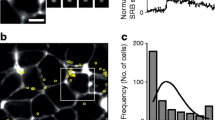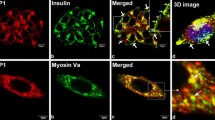Abstract
The PDZ domain-containing protein Shank is a master scaffolding protein of the neuronal postsynaptic density and directly or indirectly links neurotransmitter receptors and cell adhesion molecules to the actin-based cytoskeleton. ProSAP/Shank proteins have recently also been detected in several non-neuronal cells in which they are mostly concentrated in the apical subplasmalemmal cytoplasm. In contrast, we have previously reported a more widespread cytoplasmic immunostaining pattern for the ProSAP1/Shank2 protein in endocrine cells at the light-microscopic level. Therefore, in the present study, we have determined the ultrastructural localization of ProSAP1/Shank2 and the ProSAP/Shank-interacting proteins ProSAPiP1 and IRSp53 in pancreatic islet and adenohypophyseal cells by using immunogold staining techniques. Dense immunolabeling of secretory granules including the granule core in cells such as hypophyseal somatotrophs and pancreatic B-cells indicates the unexpected presence of ProSAP/Shank and ProSAP/Shank-interacting proteins in the hormone-storing compartment of endocrine cells. Thus, ProSAP/Shank and certain ProSAP/Shank-interacting proteins exhibit distinct subcellular localizations in the different cell types, raising the possibility that the function of ProSAP/Shank proteins is more diverse than has been envisaged to date.






Similar content being viewed by others
References
Bockmann J, Kreutz MR, Gundelfinger ED, Böckers TM (2002) ProSAP/Shank postsynaptic density proteins interact with insulin receptor tyrosine kinase substrate IRSp53. J Neurochem 83:1013–1017
Boeckers TM (2006) The postsynaptic density. Cell Tissue Res 326:409–422
Boeckers TM, Kreutz MR, Winter C, Zuschratter W, Smalla K-H, Sanmarti-Vila L, Wex H, Langnaese K, Bockmann J, Garner CC, Gundelfinger ED (1999) Proline-rich synapse-associated protein-1/cortactin binding protein 1 (ProSAP1/CortBP1) is a PDZ-domain protein highly enriched in the postsynaptic density. J Neurosci 19:6506–6518
Boeckers TM, Mameza MG, Kreutz MR, Bockmann J, Weise C, Buck F, Richter D, Gundelfinger ED, Kreienkamp H-J (2001) Synaptic scaffolding proteins in rat brain. Ankyrin repeats of the multidomain Shank protein family interact with the cytoskeletal protein α-fodrin. J Biol Chem 276:40104–40112
Boeckers TM, Bockmann J, Kreutz MR, Gundelfinger ED (2002) ProSAP/Shank proteins—a family of higher order organizing molecules of the postsynaptic density with an emerging role in human neurological disease. J Neurochem 81:903–910
Cetin Y, Aunis D, Bader M-F, Galindo E, Jörns A, Bargsten G, Grube D (1993) Chromostatin, a chromogranin A-derived bioactive peptide, is present in human pancreatic insulin (β) cells. Proc Natl Acad Sci USA 90:2360–2364
Garner CC, Nash J, Huganir RL (2000) PDZ domains in synapse assembly and signalling. Trends Cell Biol 10:274–280
Groos S, Reale E, Luciano L (2001) Re-evaluation of epoxy resin sections for light and electron microscopic immunostaining. J Histochem Cytochem 49:397–406
Kim JY, Han W, Namkung W, Lee JH, Kim KH, Shin H, Kim E, Lee MG (2004) Inhibitory regulation of cystic fibrosis transmembrane conductance regulator anion-transporting activities by Shank2. J Biol Chem 279:10389–10396
McWilliams RR, Gidey E, Fouassier L, Weed SA, Doctor RB (2004) Characterization of an ankyrin repeat-containing Shank2 isoform (Shank2E) in liver epithelial cells. Biochem J 380:181–191
Muth E, Driscoll WJ, Smalstig A, Goping G, Mueller GP (2004) Proteomic analysis of rat atrial secretory granules: a platform for testable hypotheses. Biochim Biophys Acta 1699:263–275
Pabst H, Redecker P (1999) Interstitial glial cells of the gerbil pineal gland display immunoreactivity for the metabotropic glutamate receptors mGluR2/3 and mGluR5. Brain Res 838:60–68
Redecker P, Bargsten G (1993) Synaptophysin—a common constituent of presumptive secretory microvesicles in the mammalian pinealocyte: a study of rat and gerbil pineal glands. J Neurosci Res 34:79-96
Redecker P, Seipelt A, Jörns A, Bargsten G, Grube D (1992) The microanatomy of canine islets of Langerhans: implications for intra-islet regulation. Anat Embryol 185:131–141
Redecker P, Cetin Y, Grube D (1995) Differential distribution of synaptotagmin I and rab3 in the anterior pituitary of four mammalian species. Neuroendocrinology 62:101–110
Redecker P, Cetin Y, Korf H-W (1996) Differential immunocytochemical localization of calretinin in the pineal gland of three mammalian species. J Neurocytol 25:9–18
Redecker P, Gundelfinger ED, Boeckers TM (2001) The cortactin-binding postsynaptic density protein ProSAP1 in non-neuronal cells. J Histochem Cytochem 49:639–648
Redecker P, Kreutz MR, Bockmann J, Gundelfinger ED, Boeckers TM (2003) Brain synaptic junctional proteins at the acrosome of rat testicular germ cells. J Histochem Cytochem 51:809–819
Sala C, Piech V, Wilson NR, Passafaro M, Liu G, Sheng M (2001) Regulation of dendritic spine morphology and synaptic function by Shank and Homer. Neuron 31:115–130
Schuetz G, Rosario M, Grimm J, Boeckers TM, Gundelfinger ED, Birchmeier W (2004) The neuronal scaffold protein Shank3 mediates signaling and biological function of the receptor tyrosine kinase Ret in epithelial cells. J Cell Biol 167:945–952
Sheng M, Sala C (2001) PDZ domains and the organization of supramolecular complexes. Annu Rev Neurosci 24:1–29
Soltau M, Richter D, Kreienkamp HJ (2002) The insulin receptor substrate IRSp53 links postsynaptic Shank1 to the small G-protein cdc42. Mol Cell Neurosci 21:575–583
Soltau M, Berhörster K, Kindler S, Buck F, Richter D, Kreienkamp HJ (2004) Insulin receptor substrate of 53 kDa links postsynaptic Shank to PSD-95. J Neurochem 90:659–665
Stefan Y, Meda P, Neufeld M, Orci L (1987) Stimulation of insulin secretion reveals heterogeneity of pancreatic B cells in vivo. J Clin Invest 80:175–183
Utleg AG, Yi EC, Xie T, Shannon P, White JT, Goodlett DR, Hood L, Lin B (2003) Proteomic analysis of human prostasomes. Prostate 56:150–161
Wendholt D, Spilker C, Schmitt A, Dolnik A, Smalla K-H, Proepper C, Bockmann J, Sobue K, Gundelfinger ED, Kreutz MR, Boeckers TM (2006) ProSAP interacting protein 1 (ProSAPiP1), a novel protein of the postsynaptic density that links the spine associated RAP-GAP (SPAR) to the scaffolding protein ProSAP2/Shank3. J Biol Chem 281:13805–13816
Acknowledgments
We thank H. Böning and D. von Mayersbach for excellent technical assistance, and Dr. S. Groos for advice concerning the use of thermocycling for immunoelectron microscopy.
Author information
Authors and Affiliations
Corresponding author
Additional information
This work was supported by the Deutsche Forschungsgemeinschaft (SFB 497/B8 to J.B. and T.M.B.).
Rights and permissions
About this article
Cite this article
Redecker, P., Bockmann, J. & Böckers, T.M. Secretory granules of hypophyseal and pancreatic endocrine cells contain proteins of the neuronal postsynaptic density. Cell Tissue Res 328, 49–55 (2007). https://doi.org/10.1007/s00441-006-0309-y
Received:
Accepted:
Published:
Issue Date:
DOI: https://doi.org/10.1007/s00441-006-0309-y




